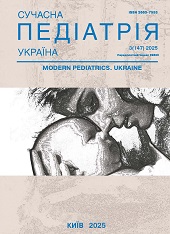A clinical case of tricuspid valve damage due to blunt chest trauma in a child
DOI:
https://doi.org/10.15574/SP.2025.3(147).132136Keywords:
blunt chest trauma, tricuspid valve, tricuspid valve anterior leaflet detachment, childrenAbstract
Traumatic valve lesions in children are extremely rare. As a rule, these are isolated cases associated with high-intensity blunt trauma. Clinical manifestations in the initial period depend on which valve is affected and the severity of its damage and in the vast majority of cases patients may remain asymptomatic for a long time. According to the literature, trauma of the tricuspid valve is the least common.
The aim is to present a clinical case of detachment of the anterior leaflet and papillary muscles of the tricuspid valve in a 6-year-old boy due to a blow to the chest with a horse's hoof.
The article presents a clinical case of damage of the tricuspid valve caused by blunt chest trauma after a horse kick in a 6-year-old boy. During the physical examination, the child showed signs of heart failure: dyspnea, tachycardia, a harsh 3/6 systolic murmur in the tricuspid valve auscultation area, hepatomegaly and severe chest pain. The electrocardiogram showed signs of right ventricular hypertrophy, right atrial enlargement and tachycardia, and a chest X-ray showed mild cardiomegaly. On echocardiographic examination, the diagnosis was confirmed: rupture of tricuspid valve anterior leaflet with papillary muscles and severe tricuspid insufficiency. After the diagnosis was confirmed, the child was transferred to a specialized cardiac surgery center, where tricuspid valve repair was performed urgently. Several clinical cases are presented in the literature in which children had no clinical manifestations immediately after chest trauma, but signs of heart failure developed in coulple months.
Conclusions. Transthoracic echocardiography plays a key role in the diagnosis of valve damage and allows for timely surgical correction. It is important to perform echocardiographic examination of the heart in all children after blunt chest trauma, even in the absence of cardiovascular complaints or clinical signs of heart failure, as intracardiac changes can progress over time and clinical signs can develop in the following months.
The research was carried out in accordance with the principles of the Helsinki Declaration. The informed consent of the patients was obtained for the study.
The authors declare no conflict of interest.
References
Banning A, Durrani A, Pillai R. (1997). Rupture of the atrial septum and tricuspid valve after blunt chest trauma. Ann. Thorac. Surg. 64: 240-242. https://doi.org/10.1016/S0003-4975(97)00275-0; PMid:9236372
Bertrand S, Laquay N, El Rassi I, Vouhé P. (1999, Nov). Tricuspid insufficiency after blunt chest trauma in a nine year old child. European Journal of Cardiothoracic Surgery. 16(5): 587-589. https://doi.org/10.1016/S1010-7940(99)00302-4; PMid:10609917
De México C. (2020). Traumatic tricuspid regurgitation in a pediatric patient: Is an early diagnosis possible? Arch. Cardiol. Méx. 90. Epub. 23 Oct 2020. https://doi.org/10.24875/ACME.M20000118; PMid:32897255
Dowd MD, Krug S. (1996, Jan). Pediatric blunt cardiac injury: epidemiology, clinical features, and diagnosis. Pediatric Emergency Medicine Collaborative Research Committee: Working Group on Blunt Cardiac Injury. J Trauma. 40(1): 61-67. https://doi.org/10.1097/00005373-199601000-00012; PMid:8577001
Eranki A, Villanueva C, Wilson-Smith A, Seah P. (2021, Dec 23). Traumatic tricuspid valve regurgitation: A two case series. Trauma Case Rep. 37: 100593. https://doi.org/10.1016/j.tcr.2021.100593; PMid:35059490 PMCid:PMC8760512
Fujiwara K, Hisaoka T, Komai H, Nishimura Y, Yamamoto S, Okamura Y. (2005). Successful repair of traumatic tricuspid valve regurgitation. Jpn J Thorac Cardiovasc Surg. 53: 259-262. https://doi.org/10.1007/s11748-005-0036-4; PMid:15952318
Loar RW, Maskatia SA, McLaughlin ES, Mott AR, Adachi I, Fraser CD. (2016, Mar). Complex Surgical Repair of a Flail Tricuspid Valve After Chest Wall Trauma in a Pediatric Patient. Ann Thorac Surg. 101(3): e65-7. https://doi.org/10.1016/j.athoracsur.2015.09.041; PMid:26897232
Ma W, Luo G, Sun H, Xu J, Hu S, Zhu X. (2010). Surgical treatment of traumatic tricuspid insufficiency:experience in 13 cases. Ann Thorac Surg. 90: 1934-1938. https://doi.org/10.1016/j.athoracsur.2010.07.081; PMid:21095339
Maisano F, Lorusso R, Sandrelli L et al. (1996). Valve repair for traumatic tricuspid regurgitation. Eur. J. Cardiothorac. Surg. 10: 867-873. https://doi.org/10.1016/S1010-7940(96)80313-7; PMid:8911840
Stoica B, Paun S, Tanase I, Negoi I, Runcanu A, Beuran M. (2015, Sep-Oct). Traumatic Tricuspid Valve Rupture after Blunt Chest Trauma - A Case Report and Review of the Literature. Chirurgia (Bucur). 110(5): 467-470. PMID: 26531792.
Vayre F, Richard P, Ollivier JP. (1996). Traumatic tricuspid insufficiency. Arch. Mal. Coeur Vaiss. 89: 459-463.
Zakynthinos E, Vassilakopoulos T, Routsi C, Roussos C, Zakynthinos S. (2002). Early- and late-onset atrioventricular valve rupture after blunt chest trauma:the usefulness of transesophageal echocardiography. J Trauma. 52: 990-996. https://doi.org/10.1097/00005373-200205000-00028; PMid:11988671
Zhang Z, Yin K, Dong L, Sun Y, Guo C, Lin Y et al. (2017). Surgical management of traumatic tricuspid insufficiency. J. Card. Surg. 32: 342-346. https://doi.org/10.1111/jocs.13156; PMid:28543789
Downloads
Published
Issue
Section
License
Copyright (c) 2025 Modern pediatrics. Ukraine

This work is licensed under a Creative Commons Attribution-NonCommercial 4.0 International License.
The policy of the Journal “MODERN PEDIATRICS. UKRAINE” is compatible with the vast majority of funders' of open access and self-archiving policies. The journal provides immediate open access route being convinced that everyone – not only scientists - can benefit from research results, and publishes articles exclusively under open access distribution, with a Creative Commons Attribution-Noncommercial 4.0 international license (СС BY-NC).
Authors transfer the copyright to the Journal “MODERN PEDIATRICS. UKRAINE” when the manuscript is accepted for publication. Authors declare that this manuscript has not been published nor is under simultaneous consideration for publication elsewhere. After publication, the articles become freely available on-line to the public.
Readers have the right to use, distribute, and reproduce articles in any medium, provided the articles and the journal are properly cited.
The use of published materials for commercial purposes is strongly prohibited.

